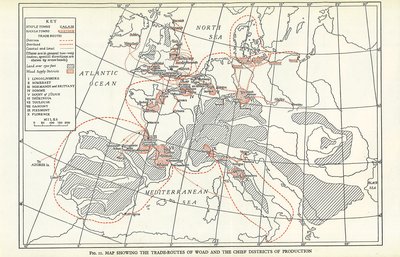The War Between Woad and Indigo
The story of colors is often a story of exploration and trade, commerce and nationalism. Even Paleolithic artifacts appear to include pigments not found in the immediate region. As new sources for colors were found, entire trade routes and industries could become obsolete
The dark blue of indigo dye was much prized both for its color and its lightfast qualities (used, for instance, by Napoleon to outfit his army). In Roman times indigo was such a mysterious import that the dried bricks of dye were thought to be a stone.
Almost identical version of the dye come from two different plants, the Indigofera tinctoria indigo plant of South Asia and the Isatia tinctoria woad plant which produces a weaker dye but could grow in the colder climate of Europe.
Woad was a major European industry since early medieval times but it was not without its consequences. The plant strips the land of its nutrients and threatened starvation for the local farming populations. The fermentation required to process woad into balls for distribution produced a pungent ammonia odor. Nevertheless, when the opening of trade routes with India in the 16th century threatened the lucrative woad industry with the importation of the far superior indigo dye, a battle began to discredit indigo and protect the local industry. By the 18th century, the French and German governments were attempting to pass laws to restrict importation of the rival dye.

